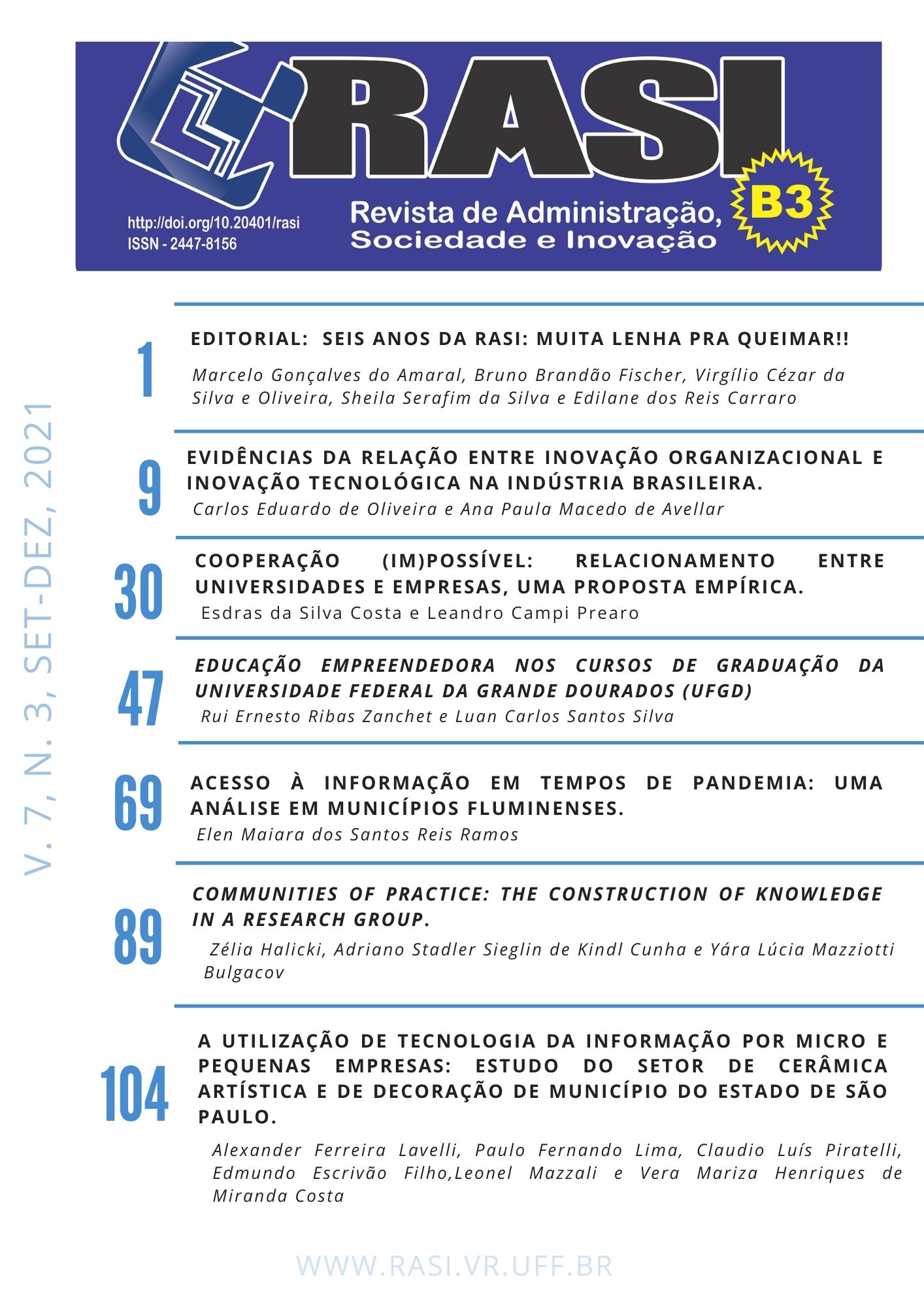Evidence of the Relationship between Organizations Innovation and Technological Innovation in Brasilian Industries
DOI:
https://doi.org/10.20401/rasi.7.3.463Keywords:
Inovação. Inovação Organizacional. Inovação Tecnológica. PINTEC.Abstract
The aim of this study was to determine whether there is complementarity of Organizational Innovation (OI) with technological innovation (IT). For the empirical analysis, we used as 2008 editions database and 2011 Innovation Research (PINTEC) conducted by the Brazilian Institute of Geography and Statistics (IBGE). The results of empirical analysis in companies located in Brazil show that: i) the number of enterprises that have IO concurrently with another type of innovation (product, process or marketing) are higher than the group of companies held only IT (product or process ); ii) companies that perform more than one type of innovation have a distinct profile in relation to indicators cooperative relations, foreign capital, group, export, government support, R & D and continuous on innovative activities superior to groups and companies that carry only one type of innovation; and iii) the correlation analysis shows the existence of positive and weak correlation between IO and IT.
Downloads
References
Angle, H. L. (1989). Psychology and organizational innovation. In: Research on the Management of Innovation. New York: Ballinger.
Birkinshaw, J., Hamel, G., Mol, M. J. (2008). Management innovation. Academy of Management Review, 33(4).
Bresnahan, T. F., Brynjolfsson, E., Hitt, L. M. (2002). Information technology, workplace organization, and the demand for skilled labor: firm-level evidence. The Quarterly Journal of Economics, February, p. 339-376.
Brynjolfsson, E. Hitt, L. M., Yang. S.(2002). Intangible assets: computers and organizational capital. Brookings Papers on Economic Activity: Brookings Institution.
Camisón, C., Villar-López, A. (2011). Non-technical innovation: organizational memory and learning capabilities as antecedent factors with effects on sustained competitive advantage. Industrial Marketing Management, 40, p. 1294–1304.
_________________. (2014). Organizational innovation as an enabler of technological innovation capabilities and firm performance. Journal of Business Research, 67, p. 2891–2902.
Chandler, G. N., Keller, C., Lyon, D. W. (2000). Unraveling the determinants and consequences of an innovation-supportive organizational culture. Entrepreneurship: Theory & Practice, 25(1), p. 59–76.
Chen, J., Zhaohui, Z., Xie, H. Y. (2004). Measuring intellectual capital. Journal of Intellectual Capital, 5(1), p. 195-212.
Damanpour, F. (1987). The adoption of technological, administrative and ancillary innovations: impact of organizational factors. Journal of Management, 13(4), p. 675–688.
Damanpour, F., Szabat, K. A., Evan, W. M. (1989). The relationship between types of innovation and organizational performance. Journal of Management Studies, 26(6), p. 587–601.
Evangelista, R., Vezzani, A. (2010). The economic impact of technological and organizational innovations: a firm-level analysis. Research Policy, 39, p. 1253–1263.
Freitas, I. M. B. (2008). Sources of differences in the pattern of adoption of organizational and managerial innovations from early to late 1990s, in the UK. Research Policy, 37(1).
Gallego, J., Rubalcaba, L., Hipp, C. (2012). Organizational innovation in small European firms: a multidimensional approach. International Small Business Journal, 31, fev.
Ganter, A., Hecker, A. (2013) (a). Configurational paths to organizational innovation: qualitative comparative analyses of antecedents and contingencies. Journal of Business Research.
Ganter, A., Hecker, A. (2013) (b). Deciphering antecedents of organizational innovation. Journal of Business Research, 66, p. 575–584.
Guan, J., Liu, J. (2007). Integrated innovation between technology and organization. International Journal of Innovation Management, 4(4).
Gunday, G., Ulusoy, G., Kilic, K., Alpkan, L. (2011). Effects of innovation types on firm performance. International Journal of Production Economics, 133(2), p. 662-676.
Hassan, M. U., Shaukat, S., Nawaz, M. S., Naz, S. (2013). Effects of innovation types on firm performance: an empirical study on Pakistan’s Manufacturing Sector. Pakistan Journal of Commerce and Social Sciences, 7(2), p. 243-262.
IBGE - Instituto Brasileiro de Geografia e Estatística (2010). Pesquisa de inovação – PINTEC 2008. Rio de Janeiro: IBGE.
IBGE - Instituto Brasileiro de Geografia e Estatística (2013). Pesquisa de inovação – PINTEC 2011. Rio de Janeiro: IBGE.
Kessler, E. H. (2004). Organizational innovation: a multi-level decision-theoretic perspective. International Journal of Innovation Management, 8(3).
Kimberly, J. R., Evanisko, M. J. (1981). Organizational innovation: the influence of individual, organizational, and contextual factors on hospital adoption of technological and administrative innovations. The Academy of Management Journal, 24(4), p. 689-713.
Lam, A. (2005). The Oxford handbook of innovation. Oxford, UK: Oxford University, Press.
Lin, C. Y., Chen, M. Y. (2007). Does innovation lead to performance? An empirical study of SMEs in Taiwan. Management Research News, 30(2), p. 115-132.
Lynch, L. M. (2007). The adoption and diffusion of organizational innovation: evidence for the U.S. economy. National Bureau of Economic Research (NBER), Working Paper n. 13156, Cambridge, jun.
Mol, M. J., Birkinshaw, J. (2009). The sources of management innovation: when firms introduce new management practices. Journal of Business Research, 62, p.1269–1280.
OCDE. (2005). Manual de Oslo: diretrizes para coleta e interpretação de dados sobre inovação. 3ª ed. Rio de Janeiro: FINEP.
Olson, E. M., Slater, S. F., Hult, G. T. (2005). The performance implications of fit among business strategy, marketing organization structure, and strategic behavior. Journal of Marketing, 69(3), p. 49–65.
Pallas, F., Böckermann, F., Goetz, O., Tecklenburg, K. (2013). Investigating organizational innovativeness: developing a multidimensional formative measure. International Journal of Innovation Management, 17(4).
Prester, J., Bozac, M. G. (2012). Are innovative organizational concepts enough for fostering innovation? International Journal of Innovation Management, 16(1).
Santos-Vijande, M. L., Álvarez-González, L. I. (2007). Innovativeness and organizational innovation in total quality oriented firms: the moderating role of market turbulence. Technovation, 27(9), p. 514–532.
Sapprasert, K., Clausen, T. H. (2012). Organizational innovation and its effects. Industrial and Corporate Change, 21(5), p. 1283–1305.
Schmidt, T., Rammer, V. (2007). Non-technological and technological innovation: strange bedfellows? ZEW Discussion Papers, p. 07-052.
Siguaw, J. A., Simpson, P. M., Enz, C. A. (2006). Conceptualizing innovation orientation: a framework for study and integration of innovation research. Journal of Product Innovation Management, 23(6), p. 556–574.
Silva, A. L. G. (2010). Concorrência sob condições oligopolísticas. Campinas: Unicamp.
Wischnevsky, J. D., Damanpour, F., Méndez, F. A. (2011). Influence of environmental factors and prior changes on the organizational adoption of changes in products and in technological and administrative processes. British Journal of Management, 22, p. 132–149.
Downloads
Published
Issue
Section
License
Copyright (c) 2021 Review of Administration, Society and Innovation

This work is licensed under a Creative Commons Attribution 4.0 International License.
RASI, in accordance with Law No. 9,610 of February 19, 1998, which amends, updates and consolidates Brazilian copyright law and makes other provisions, adopts the following conditions of the Copyright Assignment:
1. RASI maintains, with the transfer of copyrights, the possession of rights over the content published;
2. The author retains his moral rights of the content, including the right to be identified as the author whenever the content is published;
3. Despite the attribution of copyright, the author retains the right to reuse the material in future collections of his own work without encumbrance. The acknowledgments of the previous publication in the RASI are the only requirements in such cases;
4. The author may make photocopies of the content, or distribute it by electronic mail or fax, provided that they are intended for their own classes and for the purpose of meeting research objectives, provided that: (a) such copies are not resold and (b) reference to the original source of the publication and the name of the RASI are clearly indicated on all copies made of the document.











